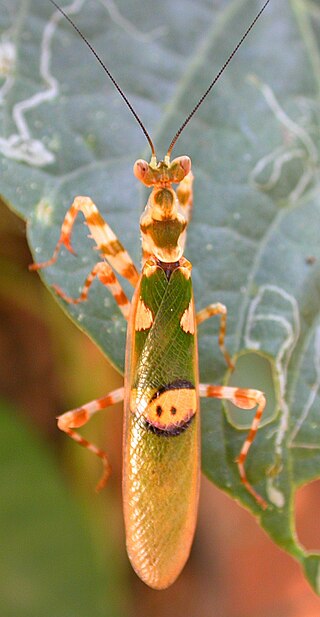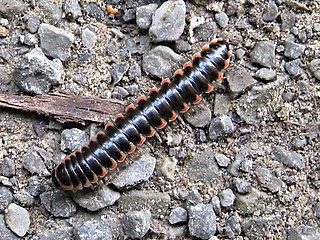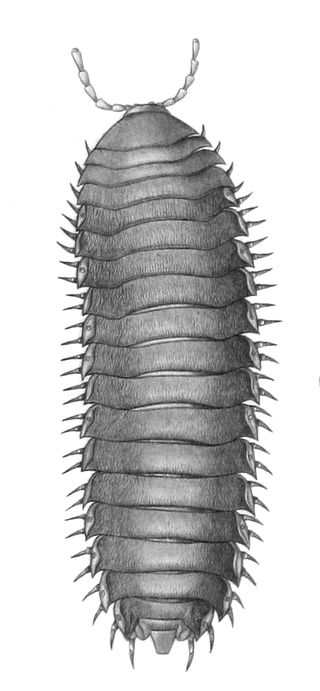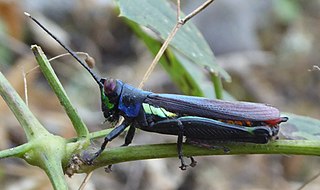
Polistes is a cosmopolitan genus of paper wasps and the only genus in the tribe Polistini. Vernacular names for the genus include umbrella wasps, coined by Walter Ebeling in 1975 to distinguish it from other types of paper wasp, in reference to the form of their nests, and umbrella paper wasps. Polistes is the single largest genus within the family Vespidae, with over 200 recognized species. Their innate preferences for nest-building sites leads them to commonly build nests on human habitation, where they can be very unwelcome; although generally not aggressive, they can be provoked into defending their nests. All species are predatory, and they may consume large numbers of caterpillars, in which respect they are generally considered beneficial.

Ensifera is a suborder of insects that includes the various types of crickets and their allies including: true crickets, camel crickets, bush crickets or katydids, grigs, weta and Cooloola monsters. This and the suborder Caelifera make up the order Orthoptera. Ensifera is believed to be a more ancient group than Caelifera, with its origins in the Carboniferous period, the split having occurred at the end of the Permian period. Unlike the Caelifera, the Ensifera contain numerous members that are partially carnivorous, feeding on other insects, as well as plants.

Bandwings, or band-winged grasshoppers, are the subfamily Oedipodinae of grasshoppers classified under the family Acrididae. They have a worldwide distribution and were originally elevated to full family status as the Oedipodidae. Many species primarily inhabit xeric weedy fields, and some are considered to be important locusts:

Creobroter is a genus of flower mantises in the tribe Hymenopodini; species are concentrated in Asia. The name comes from the Greek kreo-, meaning "flesh") and broter" meaning "eating", therefore, "flesh-eating", an apt name for a predatory insect. Both sexes have long wings and are capable fliers. Full-grown males are about 3 to 4 cm in length; females are about 4 to 5 cm.

Neonemobius is a genus of crickets in the subfamily Nemobiinae. All species are recorded from North America.

Anterhynchium is an Afrotropical, Indomalayan, Australian and Palearctic genus of potter wasps. As in many species of wasp, female wasps defend against predation using a modified ovipositor to sting predators. Like some other wasps in the Vespidae family, male wasps can produce a "pseudo-sting" with two sharp spines on either side of their genitals; however, unlike in the females, this "sting" is venomless.

Gryllus is a genus of field cricket. Members of the genus are typically 15–31 mm long and darkly coloured. The type species is Gryllus campestris L.: the European field cricket.

Ropalidia is a large genus of eusocial paper wasps (Polistinae) in the tribe Ropalidiini distributed throughout the Afrotropical, Indomalayan and Australasian biogeographical regions. The genus Ropalidia is unusual because it contains both independent and swarm-founding species. Ropalidia romandi is one of the swarm founding species, meaning that new nests are founded by a large group of workers with a smaller number of inseminated females, while Ropalidia revolutionalis is independent-founding, meaning that each nest is founded by a single foundress.

Scolia is a genus of scoliid wasps in the subfamily Scoliinae. There are over 200 described species in Scolia.

Sipyloidea is a genus of stick insects of the family Lonchodidae. Species have been recorded from India, China, Indochina, through to Australasia. The genus was described by Brunner von Wattenwyl in 1893.

Rhysodesmini is a tribe of flat-backed millipedes in the family Xystodesmidae. There are about 11 genera and at least 90 described species in Rhysodesmini.

Rhysodesmus is a genus of flat-backed millipedes in the family Xystodesmidae. There are at least 90 described species in Rhysodesmus., ranging from El Salvador to the Southern United States.

Ripipterygidae is a family of insects in the order Orthoptera. Members of the family are commonly known as mud crickets.
Anabropsis is a genus of king crickets in the tribe Anabropsini. They are found tropical areas of the Americas, Africa and Asia.

Orophus is a small genus of katydids native to Mexico, Central America, and South America.

Gryllini is a tribe of crickets and typical of the family Gryllidae. Species are terrestrial, carnivorous or omnivorous and can be found in all continenents except Antarctica.

Pseudovates is a genus of praying mantis in the family Mantidae. There are more than 20 described species in the genus Pseudovates, and are found in North, Central, and South America.

Proctolabus is a genus of short-horned grasshoppers in the family Acrididae. There are about eight described species in Proctolabus, found in Mexico and the southwestern United States.

Zoosphaerium is a genus of giant pill millipedes endemic to Madagascar. Some species within this genus express island gigantism. The largest of the known species of giant pill millipede known is Zoosphaerium neptunus, which is capable of growing to lengths of 90 mm.

















